 Subaru Forester: Changing a flat tire
Subaru Forester: Changing a flat tire

- Do not jack up the vehicle on an incline or a loose road surface.
The jack can come out of the jacking point or sink into the ground and this can result in a severe accident.
- Use only the jack provided with your vehicle. The jack supplied with the vehicle is designed only for changing a tire. Never get under the vehicle while supporting the vehicle with this jack.
- Always turn off the engine before raising the flat tire off the ground using the jack. Never swing or push the vehicle supported with the jack. The jack can come out of the jacking point due to a jolt and this can result in a severe accident.
1. Park on a hard, level surface, whenever possible, then stop the engine.
2. Set the parking brake securely and shift the shift lever in reverse (MT models) or the select lever in the “P” (Park) position (AT models).
3. Turn on the hazard warning flasher and have everyone get out of the vehicle.

4. Put wheel blocks at the front and rear of the tire diagonally opposite the flat tire.
5. Take out the jack, jack handle and wheel nut wrench.
The tools and the spare tire are stored under the floor of the cargo area. Refer to “Maintenance tools”.
NOTE
Make sure that the jack is well lubricated
before using it.
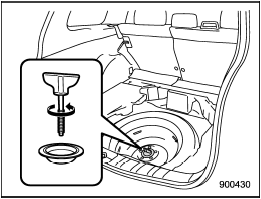
Models with standard spare tire
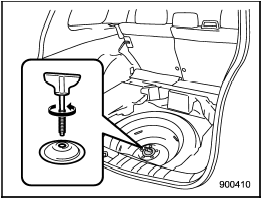
Models with temporary spare tire
6. Take out the tool bucket and turn the attaching bolt counterclockwise, then take the spare tire out.
NOTE
If the spare tire provided in your vehicle
is a temporary spare tire, carefully read
“Temporary spare tire” and
strictly follow the instructions.
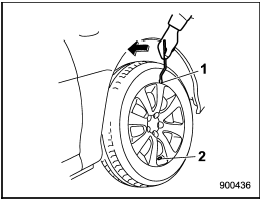
1) Notch
2) Valve hole
7. If your vehicle has wheel covers, insert a wheel cover remover into the notch on the opposite side of the valve hole and pry the wheel cover to remove it.
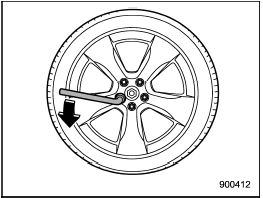
8. Loosen the wheel nuts using the wheel nut wrench but do not remove the nuts.
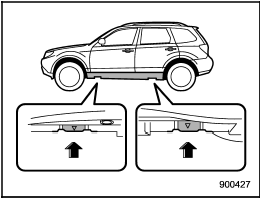
9. Place the jack under the side sill at the front or rear jack-up point closest to the flat tire.
Turn the jackscrew by hand until the jack head engages firmly into the jack-up point.
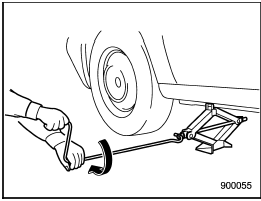
10. Insert the jack handle into the jackscrew, and turn the handle until the tire clears the ground. Do not raise the vehicle higher than necessary.
11. Remove the wheel nuts and the flat tire.


12. Before putting the spare tire on, clean the mounting surface of the wheel and hub with a cloth.
13. Put on the spare tire. Replace the wheel nuts. Tighten them by hand.

Do not use oil or grease on the wheel studs or nuts when the spare tire is installed. This could cause the nuts to become loose and lead to an accident.
14. Turn the jack handle counterclockwise to lower the vehicle.
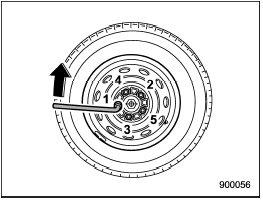
15. Use the wheel nut wrench to securely tighten the wheel nuts to the specified torque, following the tightening order in the illustration.
For the wheel nut tightening torque, refer to “Tires”. Never use your foot on the wheel nut wrench or a pipe extension on the wrench because you may exceed the specified torque. Have the wheel nut torque checked at the nearest automotive service facility.
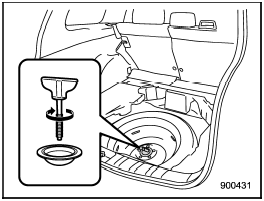
16. Store the flat tire in the spare tire compartment. Put in the spacer and tighten the attaching bolt firmly.
Also store the jack, jack handle and wheel nut wrench in their storage locations.

Never place a tire or tire changing tools in the passenger compartment after changing wheels. In a sudden stop or collision, loose equipment could strike occupants and cause injury. Store the tire and all tools in the proper place.
 Flat tires
Flat tires
If you have a flat tire while driving, never
brake suddenly; keep driving straight
ahead while gradually reducing speed.
Then slowly pull off the road to a safe
place. ...
 Tire pressure monitoring system (TPMS) (U.S.-spec. models)
Tire pressure monitoring system (TPMS) (U.S.-spec. models)
Type A
Type B
The tire pressure monitoring system provides
the driver with the warning message
indicated by sending a signal from a
sensor that is installed in each wheel
when tire p ...
See also:
To close the moonroof
Push the switch to the “CLOSE” side then
quickly release it to close the moonroof.
The moonroof will stop at a position 8 in
(20 cm) away from the fully closed
position. Push the switch aga ...
Map light
Map light
1) Map light switch (lens)
To turn on the map light, push the lens.
To turn it off, push the lens again.
When leaving the vehicle, make sure the
lights are turned off to avoid batt ...
Defrosting or defogging
Defrosting or defogging
To direct warm air to the windshield and
front door windows:
1. Set the airflow control dial to the “”
position.
2. Set the temperature control dial to the
red ...
